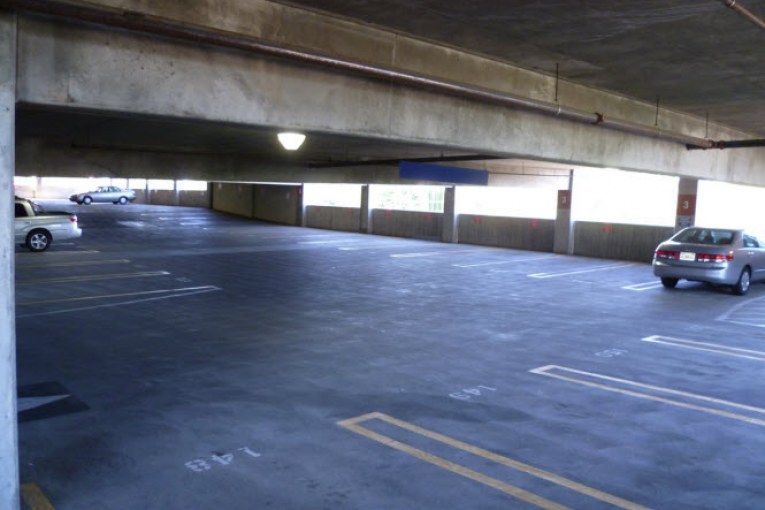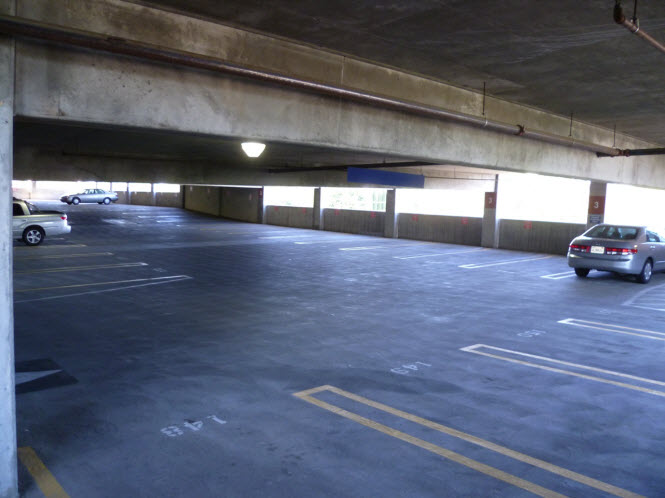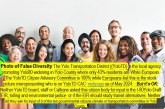

Mandating Parking Spaces Is Bad for the Environment, and Bad for Housing Affordability
By David M. Greenwald
Executive Editor
Davis, CA – When the city of Davis approved its Downtown Plan earlier this year, it set the maximum allowed spaces for residential units at .75 spaces per unit for studios and one bedrooms and one per unit for two or more bedrooms. It did away with parking minimums.
That follows a statewide trend. Last September, Governor Newsom signed Assemblymember Friedman’s AB 2097 which would eliminate parking minimums near transit.
AB 2097, a release explained, “abolishes parking requirements within one half mile of major transit stops, meaning developers will no longer be required to build any pre-set minimum number of parking spaces per a residential unit or per square foot of commercial developments.”
This is the clear trend—the question is why is this the clear trend when the first thing people complain about when these projects have come forward is that there is  insufficient parking.
insufficient parking.
The biggest reason is cost.
Assemblymember Friedman for example explained last year, “On average, a garage costs $24 -$34,000 per space to build, and an underground parking space costs $50-$65,000 to build. These costs get passed onto individuals and families, even if they don’t own or cannot drive a car.”
Many also see this as the confluence between the need for affordable housing and climate resilience.
“Eliminating excessive, arbitrary and costly parking mandates near transit is key to creating greater housing affordability, transit ridership and walkable neighborhoods while reducing carbon emissions from vehicles. AB 2097 unlocks this potential and will help us build our communities in a healthier, safer and more humane way,” said Michael Lane, State Policy Director at SPUR.
“Parking requirements increase the cost of housing, and encourage car use, which drives up greenhouse gas emissions. AB 2097, which is at the nexus of both housing and climate policy, makes sense for state goals to decrease housing costs and pollution,” said Leonora Camner, Executive Director of Abundant Housing LA. “As a mom, I’m glad the state is prioritizing a safer, greener, and more affordable future.”
UCLA Distinguished Research Professor and internationally recognized parking expert Donald Shoup in 2021 recommended three key reforms:
-
- Remove off-street parking requirements. Developers and businesses can then decide how many parking spaces to provide for their customers.
- Charge the right prices for on-street parking. The right prices are the lowest prices that will leave one or two open spaces on each block, so there will be no parking shortages.
- Spend the parking revenue to improve public services on the metered streets. If everybody sees their meter money at work, the new public services can make demand-based prices for on-street parking politically popular.
Meanwhile UCLA Professor Michael Manville and colleagues looked at the impact of San Diego’s 2019 decision to stop requiring parking for housing near transit. At the time, the city did so over the objections of housing advocates, but what they found is that such laws made “100-percent-affordable projects more economically viable.”
Basically, as a study from the Terner Center for Housing Innovation at the University of California, Berkeley, found, local parking requirements add about $36,000 on average to the cost of every new housing unit in California built with the Low-Income Housing Tax Credit.
“For low-income tenants, that means fewer units. For market-rate tenants, it means higher rents,” they found.
In May, the Washington Post found that parking minimums are likely costing people hundreds more in rent.
They noted that the parking minimum rules that were developed first in the 1920s and expanded to the suburbs in the 1950s, “not only overestimated the amount of parking that was needed, they created a society that virtually demanded a car to conduct daily life.”
The Post writes, “Parking minimums shape your entire life even if you don’t realize it, from the size of your rent check to the length of your commute to how many friends live nearby. Requiring businesses to include copious parking spots raises the cost of construction and the amount of land needed, codifying sprawl.”
Moreover, “parking minimums can raise vehicle carbon emissions for generations. But unlike coal power plants and internal combustion engines, minimums are easier to scrap. There is no billion-dollar lobbying machine for parking minimums.”
We have way more parking spaces than we actually need, and “each one costs us.”
The Post also quotes Shoup, who “estimates the United States has about three spots per vehicle.”
Writes the Post, “Shoup isn’t opposed to parking. He opposes cities requiring arbitrary amounts of it, and then giving away so much street curbside parking.”
In his book, The High Cost of Free Parking, Shoup argues “minimum parking requirements raise housing costs, subsidize car ownership and congestion, increase homelessness, deter transit and pollute the air.”
Instead, Shoup argues we need to let builders “decide where to build private parking, encouraging cities to charge fair market prices for curb parking and reinvesting this revenue in public services in metered areas.”
Yeah, I know the people opposed to paid parking are having a conniption about now.
But what those people are missing is that THERE IS NO SUCH THING AS FREE PARKING.
If you don’t pay for it at the street, someone else is paying for it. And it’s probably poor people through their rent.
One such study found that the typical surface parking stall costs between $5000 and $10,000 to construct; this includes the value of the land (and this was in 2018).
A parking space in a garage can cost $25,000 to $50,000.
They add, “Excess parking has implications for housing availability in cities facing affordability and supply crunches. Developers who build parking pass the cost on to the tenant—whether that parking was required by a local parking-minimum ordinance, or would have been included anyway.”
Seth Goodman at Reinventing Parking did an analysis in 2015 of how much a parking space adds to apartment rent, and found that it added an estimated average of $225 per month to monthly rents. Again, that was back in 2015—that cost has only increased.
So the bottom line is that parking minimums are BAD—bad for housing affordability, bad for housing supply, and bad for the environment.
The law is now accommodating this. AB 2097 took effect on January 1 of this year. The city’s Downtown Plan—and the downtown is clearly in a transit stop with the train station right there—is in compliance with that law.
Under AB 2097, projects within a ½ mile of a major transit stop would no longer be required by local governments to include a minimum number of parking spaces for every residential unit or commercial business built.
They note, “The bill does not prohibit developers from providing the parking spaces they believe are needed to meet market demand, or that lenders will require.
“Rather, the bill gives homebuilders the flexibility to build projects that meet the needs of each neighborhood and the specific demographics of each project, instead of limiting them to a one-size-fits-all approach and creating unnecessary costs.”
So what happens if you have a car and want to live in the downtown? Pay for a spot. People who don’t have vehicles in the downtown shouldn’t have to subsidize your “free” parking space. The other option: don’t live in the downtown if you own a vehicle. It kind of defeats the purpose of living in downtown anyway.







Paid on-street parking downtown is not going to happen. DOA. Kaput. I suggest people stop re-litigating this topic.
There is nothing wrong with building some projects without parking minimums. But we need to be realistic about how that will skew the demographics of who will be living in those projects as well as the impact these large residential developments will have on the retail makeup of downtown Davis. The inexorable trend toward a sprawling food court will be accelerated.
We also need to understand that parking adds costs and costs also help to skew demographics.
Who do you think is going to be living in these downtown units?
Not families with school age children.
True. But that’s why we need peripheral housing as well.
In other words, “sprawl and cars for kids”. (Especially for those who don’t already live in the city.)
Has a nice ring to it.
And so much more “logical” than right-sizing the school district.
But it is true that young families have the “biggest impact of all”, in regard to demand for parking, schools, playfields, libraries, etc. Such a deal for cities!
Definitely pursue that. Sounds like a “fiscal and environmental winner”, to me!
As if it’s not enough that it’s already that way in places like Spring Lake.
“Poaching” as official city policy. (We already know that it’s school district policy.)
Most likely people working in the downtown or people who commute via Capitol Corridor. We’ll see if some of the proposed housing is for-sale.
Paid street parking will be implemented downtown within ten years, five if the proposed downtown projects are built.
Mark
I have to agree with the changed prospect for paid parking. The success in Midtown Sac where there are meters yet few open spaces shows that metering doesn’t deter business.
Ron O
Again, you aren’t using an appropriate definition of “sprawl.” Dense development by definition is not sprawl.
As for outside students coming the DJUSD, most of their parents are employed at UCD and bring their child to work when they commute in. That they bring their students here is because UCD employees have been forced out of Davis due to high housing prices created by our growth controls. (The historic data is clear on this trend.) Instead wealthier commuters have outbid them for the remaining available housing and those commuters send their children to DJUSD in place of those UCD employees. DJUSD isn’t “poaching” those students; rather our city is pushing away the workers who would reside here otherwise to be close to work and would send their students to the local school. It’s a bad situation all around, including environmentally.
Mark
I agree that paid street parking downtown is likely soon. The success of meters in Midtown Sac with no apparent loss of business illustrates the value.
Ron O
Again you’re using a sloppy definition of sprawl. Dense considered development by definition is not sprawl. The term was defined specifically to make this distinction.
DJUSD isn’t “poaching” students. Most are children of UCD employees commuting here. Those employees have been pushed out of Davis through our growth control policies that have inflated housing prices. Instead commuters have outbid these UCD workers who desire to be local and those commuters send their children to DJUSD schools despite working elsewhere. (Don’t reply that it’s the “free market” at work–a free market would allow unrestricted house building to meet demand; it’s a two sided equation.) DJUSD is meeting an education demand created by our errant housing policies.
The “definition” of sprawl that you previously provided starts out by noting that there is no single definitive definition of sprawl. Your definition then goes on to list a number of factors that often comprise sprawl; but is not a list of “quallifying” factors. “Density” is a word that has no definitive meaning in the first place.
Here’s a more-straightforward definition of sprawl, from a source that anyone with a computer is familiar with:
https://en.wikipedia.org/wiki/Urban_sprawl
In any case, what supposedly “dense” proposals on prime farmland outside city limits are you referring to?
It absolutely is poaching students, to avoid right-sizing.
Source for that? Many of them are children of DJUSD employees – who wouldn’t even be “needed” if the district right-sized itself.
Actual data does not support that theory. This has been specifically shown a number of times on here.
But it is true that some pursue housing outside of Davis, since they get more “bang for their buck”.
Housing in surrounding communities also moderates Davis housing prices.
Housing prices are different in different communities everywhere. For that matter, they are different even WITHIN a given city – including Davis.
Are you stating that housing prices “should” be the same, everywhere? Good luck with that.
Lots of Davis residents work outside of the city. I am very familiar with that. What’s your point, here?
This comment of yours is truly worth noting. You’re apparently advocating for “unrestricted house building”, with all of the environmental impacts that entails. I don’t know of any community that allows that – even in this region.
You like to re-open peripheral debates (pun intended)…
The problem with the definition you provided is that it is overly broad and eliminates the essential eliments of what makes sprawl problematic…
Dictionary definition: “the uncontrolled expansion of urban areas.”
Britannica: ” the rapid expansion of the geographic extent of cities and towns, often characterized by low-density residential housing, single-use zoning, and increased reliance on the private automobile for transportation.”
The advantage of these definitions is that they are more specific and point to the problems of sprawl rather than create a blanket definition that basically means sprawl is peripheral development which actually in effect eliminates it as a pejorative.
You are in effect by using the definition you are attempting to have a non-pejorative definition for a word with a pejorative context. I know you’ve taken it (selectively) from somewhere else, but there is a dishonest eliment to that.
You believe that Wikipedia as a source is “selective”? Compared to what?
The definitions that you’re now providing are also full of subjective and non-definitive terminology (e.g., “rapid expansion”, “often characterized by”, “increased reliance upon the private automobile” . . .).
The only thing that’s “dishonest” is to pretend that there’s a singular defintion – especially when citing sources which start out by noting that there is no singular defintion and which consist of subjective, unmeasurable components that sprawl “may” include.
The “purest”, most-simple definition is the one provided by Wikipedia. However, this definition is not in “conflict” with any of the other definitions you or Richard have provided.
In any case, what peripheral proposal do you believe includes all of the subjective, immeasurable characteristics that you believe would preclude it from being characterized as “sprawl”?
First of all, Wikipedia is simply a community of people who are essentially group editing a given subject. It’s not some sort of authoritative approach.
Second, when you Google Urban sprawl, you have a choice as to which one to select from, and you chose the one that conforms to your bias.
Third, you didn’t address the problem I identified that the definition uses a pejorative term while denuding its definition of that negative connotation. So either sprawl is a synonym for peripheral development in which cases it loses its negative context or you are attempting to graft a negative term onto a benign definition. Either way you have a problem that you have not addressed.
Again, I’ve seen the definitions that you and Richard have provided, and am not finding them to be in “conflict” with the very first sentence of the Wikipedia definition.
What “pejorative”? Are you referring to a word like “NIMBY” – which you now claim is not a “perjorative”?
But again, neither you, nor Richard have addressed any of the points I already outlined for you, above. Not even one. How about if you give that a try, first?
I don’t know why it’s so important for you or Richard to definitively “nail down” a term that your own sources note can’t be nailed-down in the manner that you’re hoping for.
But you’re certainly free to try to argue that any one of the sprawling proposals “doesn’t meet” the definition of sprawl – even using your “own” sources. Looking forward to that.
I don’t really have anything to add at this point.
You didn’t have anything to “add” in the first place.
Again, it seems that I’ve “touched a nerve” for you and Richard. Desperately trying to shape a word in advance of the large, sprawling proposals that will be presented to voters.
I don’t care how the term is spun and twisted, it’s sprawl.
This trend “accomplishes” a couple of things, at least:
1) It transfers the resulting impact to those who <em>did</em> have to pay for their parking spaces, when they purchased their property or business.
2) It encourages sprawl, as “normal” human beings (especially families) will just seek out communities which do provide parking. In Davis’ case, Spring Lake would be the closest “result”. No house there has less-than a 2-car garage, and most probably have 3 garage spaces.
It will also encourage more outbound traffic (e.g., the “CostCo Highway”), for existing Davis residents.
What we’re seeing is another sign of developer influence at the state legislature, which is nothing new. In other words, allowing developers to avoid paying for the impacts they create, while simultaneously putting forth fake “green” claims.
A couple more (got cut-off prematurely, before I could edit the comment above):
3) It encourages more outbound traffic from existing residents (e.g., the “CostCo Highway”). (Already mentioned above, but not “numbered”.)
4) It results in more of the new housing stock being occupied by students.
On a somewhat-related note, many of these same impacts would have resulted if the megadorm had been built on top of University Mall. But try as the city might, they weren’t able to screw-up that mall, after all. Meaning it will continue serving existing Davis residents (including all of the students who will move into the new housing nearby, both on-campus and off).
Well, I guess what needs to be said here is anyone advocating for minimal or no parking standards needs to support their position by selling their car and using public transit, a bicycle or walking everywhere.
That brings the question to mind, David, have you been riding your bike from home to downtown?
Since the City has done nothing to improve its public transit, none of this “eliminate parking”concept works. Plus, the City would need to brace for losing most, if not all of their retail shopping and the sales tax revenue.
One of the best ways to reduce VMT’s in Davis is that a school bus system is need instead of hundreds of cars bringing kids to and from the schools daily, particularly the Davis junior high schools and Davis High School. Why is no one advocating for that instead of concepts with unintended consequences which would just wipe out our downtown and other retail and also seriously impact residential areas?
It’s worth noting that the task force recommendation about paid parking from 2014 was that its implementation was to be simultaneous with and/or complementary to increasing parking via construction of a parking garage. Managing parking via pricing, and increased supply, were of equal weight in the task force recommendations, per at least a couple of the participants on that committee.
It makes sense that multi-story parking garage downtown would be needed as well as a much more robust public transit system citywide which Davis does not have and is needed before considering even any modest reduction in parking requirements in the City.
I don’t think the city can do anything at all about the parking minimums.
I covered that in the article, the city no longer has discretion over this issue.
The Climate Action and Adaptation Plan calls for improving transit. A school bus system is very expensive–revising the transit system is a better solution.
Reducing parking will have little effect on retail, especially since it’s already exiting downtown, in part because we made it less accessible by rejecting the Richards Blvd underpass expansion a quarter century ago. Paid parking would increase downtown parking turnover so more spaces would be available to retail, but business owners have foolishly rejected this obvious solution so far. Building a parking garage extremely expensive and a subsidy to business owners (who ironically are among the most vociferous opponents of “subsidies”) as well as a large source of GHGs from the cement. The presence of so many new residents downtown is likely the only means of boosting downtown retail. It will also create more demand for transit which will lead to an expansion of services. Likely e-bikes also will become more prevalent. In order to meet our climate action targets, we need to reduce vehicle use and ownership. Do you have a different solution?